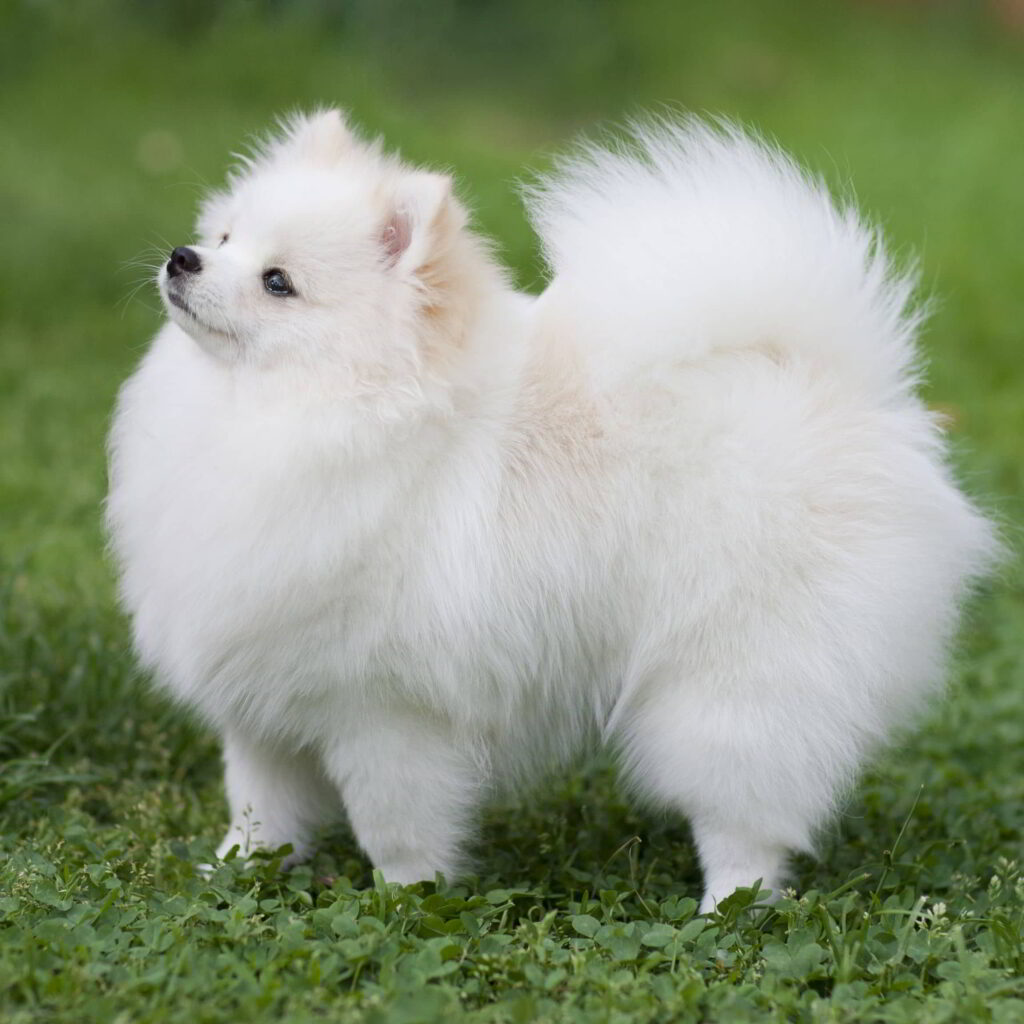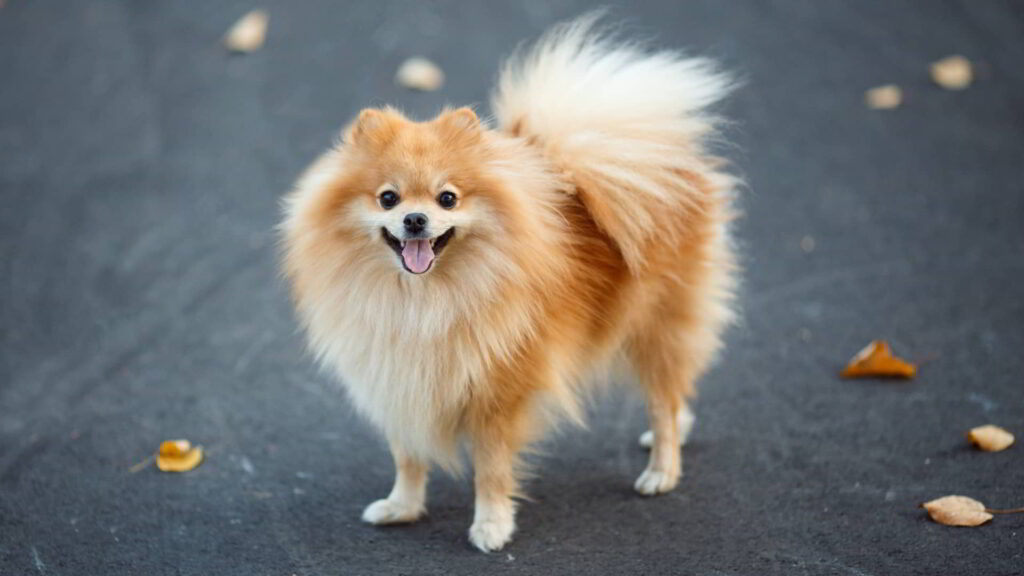Characteristics, History, Care Tips, and Helpful Information for Pet Owners
The Pomeranian is a dainty, adorable little dog with a typically friendly-though sometimes bossy-personality. Also called a “Pom,” this breed is extremely loyal to its loved ones and may be an effective guard dog despite its diminutive appearance.
With proper training, the Pomeranian can make an excellent companion, though this dog is not for everyone. Families with young children may not be an ideal home for a Pom, but the breed often gets along well with older, calmer children. If a faithful, upbeat, small dog is what you are looking for, a Pom might be the right match for you.

| Breed Overview GROUP: Toy HEIGHT: 6 To 7 Inches WEIGHT: 3 To 7 Pounds COAT AND COLOR: Long, Double Coat That Comes In Many Colors, Though The Most Common Are Red, Orange, Cream, Sable, Black, Brown, And Blue. LIFE EXPECTANCY: 12 To 16 Years |
Characteristics of the Pomeranian
| Affection Level | High |
| Friendliness | Medium |
| Kid-Friendly | Low |
| Pet-Friendly | Low |
| Exercise Needs | Low |
| Playfulness | Medium |
| Energy Level | Medium |
| Trainability | Medium |
| Intelligence | High |
| Tendency To Bark | High |
| Amount Of Shedding | High |
History of the Pomeranian
The Pomeranian is really a descendant of the sled dogs of Iceland and Lapland and is the smallest member of the spitz family of dogs. The tail curled over its back is similar to its relatives, the malamute and the Samoyed. The breed gets its name because it was developed in areas of Germany and Poland, which were then known as Pomerania. At that time, Pomeranians were larger in size than what’s common today.
In the late 1800s, Queen Victoria of England owned Pomeranians and allowed them to be shown in a conformation show, resulting in a growth in popularity of these spunky dogs. However, Poms are smart canines that respond quickly to training.
The Pomeranian gained popularity in the United States around the turn of the 20th century and remains a popular dog breed. They were officially recognized as a breed by the American Kennel Club in 1888.
Two Pomeranians were among the three dogs that survived the sinking of the Titanic in 1912. Both escaped in lifeboats with their owners, Margaret Hays and Elizabeth Barrett Rothschild.
Pomeranian Care
The Pomeranian has a long, thick, double hair coat that requires somewhat frequent grooming. Plan to brush your Pom’s coat out several times a week. Some Pom owners prefer to have their dog’s coat washed and cut by a groomer periodically, which will reduce, but not eliminate, the need for routine brushing.
Trim your dog’s nails regularly, especially if you start to hear clicking on hard surfaces. Poms can have dental problems, so it is best to brush your dog’s teeth daily.
Because of the Pom’s sometimes feisty nature, adequate training and socialization are absolutely essential. You shouldn’t be fooled by their dainty appearance. At their worst, these tough little dogs can be stubborn and pushy, a trait common amongst many toy breeds. It’s believed that this is when the Pomeranian started being bred down to a smaller size. In fact, they end up becomeing happier and more well-adjusted in the long run if they’re properly schooled.
Poms also have a medium-high energy level, so routine exercise is highly recommended. Try offering daily walks and frequent play. Your dog’s needs will depend on its size, activity level, and other factors. They have good endurance and you can take them on walks of over 5 miles without ending up carrying your pooch. Good leash training and management is important as Poms don’t realize they’re small dogs and may fearlessly confront larger dogs.
Because of their small size, a Pom can be injured from rough handling by a child. A Pom might not be a good fit for a family with small children until the kids are old enough to learn to handle dogs with care.

Poms can be good in a multi-pet household with cats and other small dogs. However, you’ll need to socialize your dogs well if introducing a Pom to a household with larger dogs, or vice versa. A Pom won’t back down from a fight with a larger dog and may be injured even in rough play.
While Poms do fairly well in cool weather, they can overheat in hot weather. They’re best as house dogs, with some access to fenced areas for play. Keep in mind that they could be preyed upon by large birds such as owls or hawks or land predators such as the coyote.
Poms are good for apartment living, but you also need to consider their tendency to bark. They’re excellent guard dogs in that they will alert you to any nearby movement. But they have big voices for tiny canines and this can be a nuisance.
A Pomeranian may be more difficult to housebreak than some breeds. Be prepared to have puppy pads and cleaning supplies handy.
Common Health Problems
Responsible breeders strive to maintain the highest breed standards as established by kennel clubs like the AKC. Dogs bred by these standards are less likely to develop hereditary conditions. However, some hereditary health problems can occur in the breed. The following are usually some conditions to be aware of:
- Patellar Luxation
- Collapsing Trachea
- Progressive Retinal Atrophy (PRA)
Diet and Nutrition
The tiny Pomeranian requires a small amount of food. Offer two meals a day of up to 1/4 cup of dry dog food. Poms will also enjoy the chance to run around occasionally (and they don’t need much space to do it). Be sure to closely monitor your dog’s weight to prevent obesity, which will shorten your dog’s lifespan. Even 1 extra pound is significant for a Pomeranian. Discuss any dietary needs with your veterinarian to get recommendations.
Pros
- Good guard dog
- Can adapt well to smaller spaces
- Energetic and loving
Cons
- Sensitive to heat
- Not the best for small children
- Can be stubborn and loud

Where to Adopt or Buy a Pomeranian
If you think you’d like to adopt a Pomeranian, start by contacting one of the following organizations:
- American Pomeranian Club
- Pomeranian Rescue
These groups will be able to provide guidance and next steps for adoption. If you aren’t certain the breed is right for you, you may be able to try fostering a Pom to see if they are a good fit for your home.
More Dog Breeds and Further Research
As with any breed, if you think the Pomeranian is right for you, be sure to do plenty of research before getting one. Talk to other Pomeranian owners, reputable breeders, and rescue groups to find out more.
If you’re interested in similar breeds, look into these to compare the pros and cons:
- Brussels Griffon
- Papillon
- Yorkshire Terrier
- Chihuahua
- Schipperke
Explore the range of dog breeds out there. With a little research, you can find the right one to bring home.
By Dog Care Tip


0 Comments